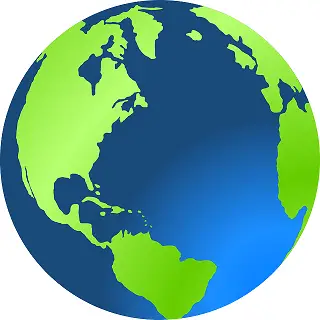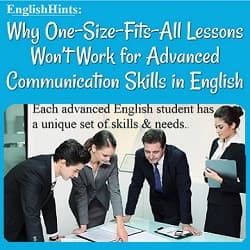Lesson Plan on the Columbian Exchange
Do you need a lesson for Columbus Day? This intermediate lesson plan on the Columbian exchange gives your students reading comprehension and past and present perfect tense practice.
Note: I'm leaving the Listening Comprehension Practice (Presentation & Practice 1) for those who subscribe to the Wall Street Journal or can adapt other material into a listening practice. However, that article is no longer available to non-subscribers.
I added an alternative video from the Khan Academy, but you would need to make your own questions for it.
Warm-up (about 5 minutes):
Ask your students what some of the effects of Columbus’s voyages were. (You might list their answers on the board.)
Introduction (1 minute):
Mention that in addition to the political, economic, and cultural changes brought by European colonization of the Americas, there were major biological effects: new foods, animals, pests, and diseases introduced to the New World (western hemisphere) and to the Old. Today we will examine some of those effects.
Optional: Presentation & Practice 1: Listening Comprehension (10 minutes)

If you subscribe to the Wall Street Journal, you can set the scene by reading/dramatizing the first 3 paragraphs + paragraphs 6-7 of this Wall Street Journal article on globalization. (It’s all interesting but the complete article is far too long and hard for intermediate ESL students.)
Announce beforehand that the introduction is about the beginning of a trading relationship involving several countries that lasted for centuries. The next paragraphs tell about potatoes and sweet potatoes, two crops from the Americas that changed the history of Europe and China. Write these words on the board and point out that
• exchange means to trade or sell one thing to get another
• vessel in this case means ship
• collide means to bump into
• predominance means having greater importance and power
Ask students to listen for answers to the worksheet (or whiteboard) questions. (See Evaluation 1.) They should discuss and record the answers in small groups after each section: paragraphs 1-3 and 6-7, then 21-25 plus a summary of 29-30.
Pause before paragraph 21 to say the next part will be about the effects of two New World tubers, potatoes and sweet potatoes, on Europe and China. Explain that a tuber is a thick underground stem. Potatoes and sweet potatoes are tubers.
Then read paragraph #21 (starting “ Compared with grains,”) to 25, & the simplified summary of paragraph 29-30 below.
Summary of paragraphs 29-30: In the summer of 1845 ships accidentally brought a very bad potato disease called ‘blight’ from South America to Europe. Beginning in Belgium and France, it spread quickly through western Europe and England and into Ireland.
People in Ireland were very poor, and depended more on potatoes than the rest of Europe did. When their potato crop was destroyed, more than a million people died and even more had to leave Ireland in order to survive. There are still fewer people in Ireland than there were in 1845.
Alternative Listening Practice
You could also use a Khan Academy video on the subject for listening plus. (I found this after I realized the article above was no longer available.)
It's quite a bit easier; 6 1/2 minutes total with an 1166-word transcript below that you could use to plan questions if desired. If your students don't know the word 'crop', you might want to teach it, as it's used nine times. The other words you might want to teach, if needed, would be enslave (used 3x), calorically (dense), manioc, and microbe (each used twice), and cassava (only used once).
That page also links to a Khan Academy article you could use, but it's considerably more difficult. It discusses mercantilism as well as the Columbian Exchange. It does have some discussion questions
(Lesson Plan on the Columbian Exchange) Evaluation 1 (10 mins.)
Give students these questions on the board or a worksheet.
(This and the other evaluations and worksheets for this lesson are also available as a pdf. Right click to download-- "save link as...")
1. Where did the exchange mentioned at the beginning of this article happen?
2. What were the main products traded?
3. Who brought them?
4. Where did they come from?
5. The article mentions four foods that are now common in certain states or countries but were not there before Columbus. Can you and your friends remember three of these foods and the places famous for them now, that didn’t have them before 1492?
Part 2
6. What New World food helped feed much of Europe, end frequent famines (times when many people could not get enough to eat and died of hunger), and let Europe become powerful?
7. What happened when Chinese farmers planted sweet potatoes on hills before they had much experience with ways to prevent erosion?
Answers:
1. In Manila (the Philippine Islands)
2. silver and silk (and porcelain)
3. The Spaniards brought silver and the Chinese brought silk (and porcelain).
4. silver—mines in the Americas; silk—China
5. oranges- Florida, tomatoes- Italy, chocolate- Switzerland, chili peppers- Thailand
6. potatoes
7. flooding (that led to political instability—bring that out in the discussion afterwards if none of the groups followed the connection.)
Practice 2: Reading (10 min.)
Have students read this short Simple-English Wikipedia article and the following two paragraphs taken from The Impact of Disease on History (see Reading Comprehension Lesson Plans—text slightly modified.)
Smallpox killed enough of the Aztecs and then the Incas to make the Spanish conquests possible. Smallpox spread south to the Incan empire even before the Spanish arrived there, and killed the old Inca, his heir, and many of their people. Their deaths led to a war over who should be the next king. That division among the Incas allowed a tiny Spanish force to conquer that great empire.
Smallpox, measles, and other Old World diseases went on to kill a large proportion (some estimates suggest over 90%) of native Americans, including those in what later became the U.S. The Pilgrims and later European settlers found only small Indian settlements and a nearly empty “wilderness” in areas that had had much larger populations before those diseases spread through the Americas.
Evaluation 2 (Reading): Group Competition (5 min.)
Divide students into groups of four or five students each. Pass out these questions to each group or have them written on the board or a poster but covered until students have finished their reading. Tell them they have up to three minutes to write one-word answers to these questions, and whichever group answers them all correctly first wins. They should raise their hands as soon as they have recorded all their answers. (If two groups finish correctly within seconds of each other, you could call it a tie.)
1. What Old World animal made a great difference in the lives of native Americans on the Great Plains in North America?
2. Name an important drink that comes from the Old World but is an important product in Latin America.
3. True or false: Bananas have always been an important food in the tropical parts of the Americas.
4. True or false: The Old World had many more domesticated animals than the New.
5. What came from the Old World and made it possible for a few Spaniards to conquer the Incas?
6. True or false: The Pilgrims and early colonists in New England found large areas of land with few native Americans because the native peoples had mostly moved to warmer climates.
Answers:
1. horses/ the horse
2. coffee
3. F
4. T
5. smallpox
6. F (actual reason: native American populations there had been greatly reduced by epidemics of smallpox, measles, and other Old World diseases.)
Practice 3: Perfect Tense Review (about 10 min.)
Pass out the Present and Past Tense Review Worksheet as individual work or homework. (See pdf.)
Application (Small group discussion: 5-10 min.)
Ask students to list at least 4 foods from the Old World and 4 from the New that they have eaten. If they could only have foods that came from one of the hemisphere, which would they choose? Why?
Home> ESL Lesson Plans> a Lesson Plan on the Columbian Exchange.
Didn't find what you
needed? Explain what you want in the search box below.
(For example, cognates, past tense practice, or 'get along with.') Click to see the related pages on EnglishHints.
| site search by freefind | advanced |







New! Comments
What do you think about what you just read? Leave me a comment in the box below.